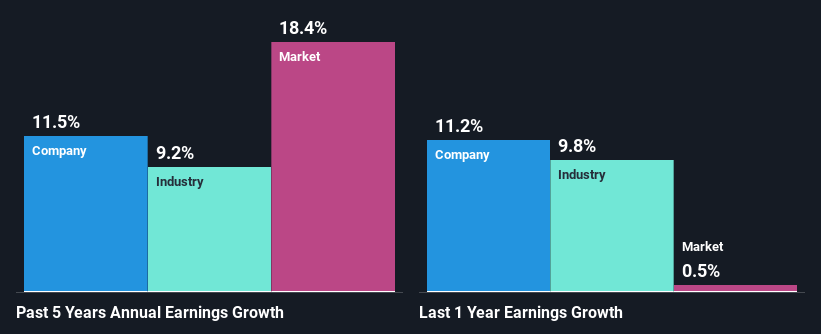Could The Market Be Wrong About Empire Company Limited (TSE:EMP.A) Given Its Attractive Financial Prospects?
It is hard to get excited after looking at Empire's (TSE:EMP.A) recent performance, when its stock has declined 3.3% over the past three months. However, stock prices are usually driven by a company’s financial performance over the long term, which in this case looks quite promising. Specifically, we decided to study Empire's ROE in this article.
ROE or return on equity is a useful tool to assess how effectively a company can generate returns on the investment it received from its shareholders. In short, ROE shows the profit each dollar generates with respect to its shareholder investments.
Check out our latest analysis for Empire
How Is ROE Calculated?
The formula for ROE is:
Return on Equity = Net Profit (from continuing operations) ÷ Shareholders' Equity
So, based on the above formula, the ROE for Empire is:
15% = CA$795m ÷ CA$5.4b (Based on the trailing twelve months to February 2024).
The 'return' is the income the business earned over the last year. So, this means that for every CA$1 of its shareholder's investments, the company generates a profit of CA$0.15.
Why Is ROE Important For Earnings Growth?
We have already established that ROE serves as an efficient profit-generating gauge for a company's future earnings. We now need to evaluate how much profit the company reinvests or "retains" for future growth which then gives us an idea about the growth potential of the company. Assuming all else is equal, companies that have both a higher return on equity and higher profit retention are usually the ones that have a higher growth rate when compared to companies that don't have the same features.
Empire's Earnings Growth And 15% ROE
To start with, Empire's ROE looks acceptable. Further, the company's ROE is similar to the industry average of 16%. Consequently, this likely laid the ground for the decent growth of 12% seen over the past five years by Empire.
As a next step, we compared Empire's net income growth with the industry, and pleasingly, we found that the growth seen by the company is higher than the average industry growth of 9.2%.
Earnings growth is an important metric to consider when valuing a stock. What investors need to determine next is if the expected earnings growth, or the lack of it, is already built into the share price. This then helps them determine if the stock is placed for a bright or bleak future. Is EMP.A fairly valued? This infographic on the company's intrinsic value has everything you need to know.
Is Empire Efficiently Re-investing Its Profits?
Empire has a low three-year median payout ratio of 22%, meaning that the company retains the remaining 78% of its profits. This suggests that the management is reinvesting most of the profits to grow the business.
Additionally, Empire has paid dividends over a period of at least ten years which means that the company is pretty serious about sharing its profits with shareholders.
Summary
In total, we are pretty happy with Empire's performance. In particular, it's great to see that the company is investing heavily into its business and along with a high rate of return, that has resulted in a sizeable growth in its earnings.
Have feedback on this article? Concerned about the content? Get in touch with us directly. Alternatively, email editorial-team (at) simplywallst.com.
This article by Simply Wall St is general in nature. We provide commentary based on historical data and analyst forecasts only using an unbiased methodology and our articles are not intended to be financial advice. It does not constitute a recommendation to buy or sell any stock, and does not take account of your objectives, or your financial situation. We aim to bring you long-term focused analysis driven by fundamental data. Note that our analysis may not factor in the latest price-sensitive company announcements or qualitative material. Simply Wall St has no position in any stocks mentioned.

 Yahoo Finance
Yahoo Finance 
